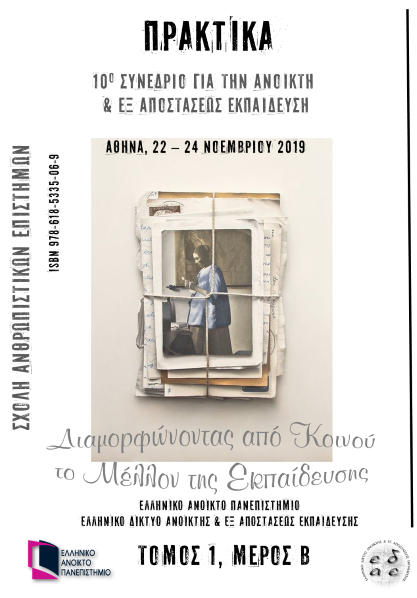Η καινοτομία στην εξ αποστάσεως εκπαίδευση μέσω της χρήσης των Τ.Π.Ε.

Περίληψη
Η πρόκληση των ιδρυμάτων εξ αποστάσεως εκπαίδευσης είναι να προωθηθεί η ανάπτυξη και η καινοτομία και να βελτιωθούν οι μαθησιακές εμπειρίες και τα αποτελέσματά τους. Από τη δεύτερη δεκαετία του 21ου αιώνα, αναγνωρίστηκε ότι η ψηφιακή επανάσταση επηρέαζε μάλλον πιο αργά την εξ αποστάσεως εκπαίδευση από άλλους τομείς. Η καινοτομία στην τεχνολογία είναι πολύ πιθανότερο να συμβεί, και ένα προτιμώμενο και επιθυμητό μέλλον, δημιουργείται εάν οι διάφοροι ενδιαφερόμενοι συνεργάζονται για να επιφέρουν αλλαγές. Για να συμβεί αυτό όμως οι στόχοι και οι αποστολές πρέπει να είναι σαφείς και οι εκπαιδευτικοί χρειάζονται υποστήριξη για να παράσχουν λύσεις σε νέες προκλήσεις και όχι να θεωρηθούν ως εμπόδια στην αλλαγή. Προκειμένου να καταστεί δυνατή η βιωσιμότητα στην εποχή της ψηφιακής μάθησης, η κλιμάκωση και ενσωμάτωση της καινοτομίας στη στρατηγική θεσμικής διαχείρισης είναι θεμελιώδης. Οι ανθρώπινες διαστάσεις της καινοτομίας, όπως η ανάπτυξη του προσωπικού για την ηλεκτρονική διδασκαλία και ο αποτελεσματικός σχεδιασμός γρήγορης μάθησης, πρέπει να στραφούν προς την πρακτική και παιδαγωγική πτυχή που επηρεάζει τη χρήση της τεχνολογίας. Ο ρυθμός της τεχνολογικής αλλαγής μειώνει τη διάρκεια ζωής των περισσότερων πόρων που βασίζονται στην τεχνολογία, αλλά τα εκπαιδευτικά ιδρύματα επιδεικνύουν μεγάλη βραδύτητα μετασχηματισμού. Όταν υιοθετείται μια συγκεκριμένη τεχνολογία ή πλατφόρμα, είναι πολύ δύσκολο να αλλάξει αργότερα. Οι βασικές δυνατότητες, ωστόσο, έχουν τη δυνατότητα να είναι πιο ανθεκτικές από τους τεχνολογικούς πόρους στους οποίους βασίζονται. Η καινοτόμος ικανότητα όμως προωθεί τη μεταφορά γνώσεων. Οι συνεργασίες και οι συμμαχίες με άλλους, ή οι κοινοπραξίες και τα κοινά έργα, προσφέρουν τρόπους διερεύνησης της καινοτομίας και των περιφερειακών τεχνολογιών με κάπως χαμηλότερο κίνδυνο. Κάθε τεχνολογική εξέλιξη πρέπει να τοποθετηθεί στο πλαίσιο και τον πολιτισμό της. Aυτό σημαίνει ότι κάθε επιμέρους ίδρυμα έχει ανάγκη να αναπτύξει ψηφιακά ενισχυμένη μάθηση που να ταιριάζει με τη δική του κουλτούρα, αλλά μέσα σε ένα γενικό πλαίσιο κοινών αναπτυξιακών αναγκών με άλλα ιδρύματα.
The challenge for distance learning institutions is to promote growth and innovation and to improve learning experience and its outcome. Since the second decade of the 21st century, it has been recognized that the digital revolution has had a rather slower impact on distance learning education than on other fields. Technology innovation is more likely to happen, and a preferred and desirable future to be created if all the people involved work together to bring about change. In order to achieve this, however, goals and objectives must be clear and educators need support to provide solutions to new challenges and not to be seen as an obstacle to the changes. In order to enable sustainability in the era of digital learning, the gradual integration and incorporation of innovation into the institutional management strategy is fundamental. The human dimensions of innovation, such as staff training for e-learning and effective design of fast learning, should focus on the practical and pedagogical aspect that is referred to influnce the use of technology. The pace of the technological change reduces the life span of most technology-based resources, but educational institutions are particular slow in terms of transformation. When a particular technology or platform is adopted, it is very difficult to change later. The most important capabilities, however, have the potential to be more resilient than the technological resources on which they are based. However, innovative capacity promotes the transition of knowledge. Collaborations and alliances with others, or joint ventures and joint projects, offer ways to explore innovation and regional technologies with a somewhat lower risk. Every technological development must be placed in its context and culture. This means that each individual institution needs to develop digitally enhanced learning that fits its own culture, but within a general context of common developmental needs with other institutions.
Λεπτομέρειες άρθρου
- Τεύχος
- Τόμ. 10 Αρ. 1B (2019)
- Ενότητα
- Τμήμα Β


